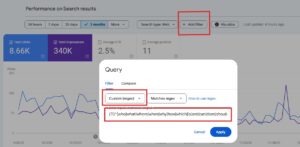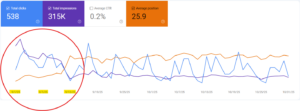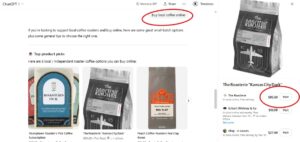A/B Testing?: A/B testing or split testing is a standard performance-measuring tool used throughout digital marketing. A/B testing is done by modifying a webpage or email newsletter and creating a second version to the original copy. Each version is then shown to a similar demographic of web visitors. The engagement rates are measured and compared to see which version received the most traffic. This tool gives marketers insight into which elements of a webpage need modifications to increase web traffic and conversion rates.
Above the Fold – The area of a web page that is visible to a user without the need to scroll. This view is often different between mobile devices and desktop monitors.
Ad Auction (aka Real Time Bidding – RTB): This is the method most often used to purchase ad space online. This determines if your ad will appear in a search query, banner ad, or video channel based on the price you are willing to pay for the ad placement.
Ad Frequency: Is the number of times a specific audience will likely view an ad within a particular time frame. Divide the number of ad impressions by its overall reach to calculate frequency. This metric shows how often the ad is displayed to the target audience.
Ad Group: A pairing of ads that share an interchangeable target audience and platform. Most ad campaigns contain multiple ad groups that are useful for organizing ads based on similarities.
Ad Placements: The list of websites where a banner (or video) ad campaign has been displayed ads.
AdSense:
Ad Network – A platform that connects advertisers with publishers to display ads on websites and apps.
AdWords – See Google Ads.
Affiliate Marketing – A performance-based marketing model in which an affiliate promotes a product or service and receives a commission for each sale made through their unique referral link.
Alt Text – The metadata of an individual image can contain alternative (alt) text. The primary use for this HTML coding is ADA compliance. For SEO purposes, this tag can also help search engines determine what the image is about and help with image search results.
Algorithm – A set of rules that a search engine or social media platform uses to rank content.
Analytics – The process of collecting, analyzing, and interpreting data about website traffic and user behavior in order to make data-driven decisions.
Anchor Text – The clickable text in a hyperlink.
Audience Segmentation – The process of dividing a target audience into smaller groups based on characteristics such as age, gender, location, interests, and behavior.
B2B – Business-to-business marketing – B2B refers to a business transaction performed between two businesses. For marketing purposes, these are campaigns which is the practice of selling products or services to other businesses is the primary goal.
B2C – Business-to-consumer marketing – A business that directly sells to the consumer. An example of a B2C business model is often product based (like Walmart or Target), where the customer is the consumer of the purchased product or service.
Backlinks – Any link on the web that links back to your website. SEO analysis of this can be found using tools like Moz, ahrefs, SEMrush and Google Search Console. For SEO purposes, the primary metrics are DA Score and unique domain backlinks.
Bing Webmaster Tools:
BOFU: Is short for “Bottom of the Funnel.” The final stage in the buyer’s journey. BOFU is a term used to define the high-quality leads in the purchase-decision stage of the selling process
Bounce Rate – The percentage of visitors who leave a website after only viewing one page. To calculate this metric, divide the total number of sessions on the website with only one pageview by the total number of website sessions.
Broad Keyword Match: A keyword matching option that will display your ad when a similar keyword or phrase is searched. This match type allows your keywords to match a wide range of possible searches
Call-to-Action (CTA) – A button or link that prompts a user to take a specific action on an ad, website, or email. With websites, these are often the desired action towards making a purchase or filling out a form.
Call Tracking:
Campaign: This is a framework for creating a Google Ads structure. Every Campaign will be made up of a set of ads, keywords, and bids that share the same target. Campaigns depict various budgets, geography, and ad-type settings.
Canonical Tag:
Cascading Style Sheet (CSS):
Click-Through Rate (CTR) – The number of clicks an ad receives is divided by the number of times the ad appeared over a defined period of time. CTR is a performance indicator that allows you to see if your ads are relevant and reach the target audience. The Average CTR of search, social, and display ads varies dramatically.
Content Management System (CMS):
Contextual Advertising:
Content Marketing – The practice of creating and sharing valuable, relevant, and consistent content to attract and retain a clearly defined audience.
Conversion – When a visitor to a website takes a desired action, such as making a purchase or filling out a form.
Conversion Rate – The total number of viewers who take the desired action on a website or advertisement. Conversion Rate is an effective metric used to identify the performance of an ad or ad channel. To calculate a conversion rate, divide the number of conversions by the total number of interactions, then convert it to a percentage
Conversion Tracking – This shows what action is made once the consumer interacts with your ad. Conversion tracking is performed within a system like Google Analytics
CopyScape –
Cost Per Acquisition (CPA) – The cost of acquiring a new customer.
Cost Per Click (CPC) – The cost an advertiser pays each time a user clicks on one of their ads.
Cost Per Impression (CPM) – The cost an advertiser pays for every 1,000 impressions of their ad.
Cost-Per-Lead (CPL):
CPM (Cost Per Mille): Also commonly referred to as cost per thousand is the common way to purchase display advertising online. On some ad platforms let advertisers pay-per-click but more often banner ads are purchased on CPM basis. The data CPM increases when you layer on audience targeting that is extremely niche by geography, demographics, and/or behavior.
The formula is: CPM = (Cost/(Impressions/1000))
Customer Relationship Management (CRM): Often synonymous with marketing automation software, a CRM it typically a 3rd party software that helps capture people’s data from the company website. When contact forms and landing page forms are completed, the CRM helps businesses organize their potential customer list. Some CRM tools will have a lead scoring feature that tracks website behavior in order to help sales teams focus on the best revenue targets.
Crawler (aks Spider or bot) – A bot that automatically scans the internet for content to index.
Customer Persona (aka Buyer Persona) – A fictional representation of a business’s ideal customer. Often times created to help target content and programmatic advertising better. Multiple personas help with audience segmentation for media buys.
Customer Relationship Management (CRM) – A system used to manage a business’s interactions with current and potential customers.
Default Channel Groupings
Demand Side Platform (DSP)
Digital Marketing – The promotion of products, services, or brands through various forms of electronic media, including websites, social media, email, and mobile apps.
Display ad: A form of online advertisement that uses visuals and other graphics to promote a product, service, or event. This type of ad will usually include a link to a website or landing page
Do-Follow Link:
Drip Campaign – An automated email marketing campaign that sends a series of messages to a subscriber over time.
Domain Authority (DA) Score – A metric used by search engines to determine how trustworthy and authoritative a website is.
Double Serving: Displaying more than one advertisement that is promoting the same product or service at the same time. A full-page takeover is when all the ad spaces are purchased by one advertiser.
Duplicate Content:
Ebook – A digital book that is typically used as a lead magnet to generate email subscribers.
Email Marketing – The use of email to promote products, services, or brands.
Engagement Rate – The level of interaction that users have with a brand’s content or social media posts.
Events (Google Analytics):
Exact Keyword Match: The Google keyword match will show your ad when the exact phrase is searched. Exact Match will not appear in a search that contains similar keyword phrases.
External Links
Facebook Advertising: See Meta Business Suite
First Meaningful Paint (FMP): Is known as the time between a page request and the user seeing the primary content load in the browser. Developers should strive to have a FMP of 1.8 seconds or less.
Funnel – The process a customer goes through from the time they first learn about a product or service to the point where they make a purchase.
GA4 – Google Analytics 4 –
GeoFencing Ads:
Geo-Targeting Ads – The practice of delivering content or ads to users based on their geographic location.
Google Ads: Formerly known as as AdWords, this is an advertising platform offered by Google that allows businesses to create and display ads on the Google search engine and other websites.
Google Analytics – A web analytics service offered by Google that tracks and reports website traffic. Marketing analytics is used to create and execute successful marketing campaigns. Tracking the performance of online marketing efforts and how the consumer interacted with the content is beneficial to customize future campaigns. Analytics delivers important data regarding online consumers’ behavior, demographics, and interests. The data gathered through analytics tracking is helpful in creating targeted ads that reach a niche audiences and foster better content.
Google Data Studio: See Google Looker Studio
Google My Business (GMB):
Google Search Console (formerly Webmaster Tools):
Gust Blogging:
HARO (Help A Reporter Out):
Hashtag – A word or phrase preceded by the # symbol used on social media to identify and categorize content.
Header Tags (H1-H6):
Headless Website:
HTML5: Latest version of HTML often used to code animated banner ads across ad networks.
HTML5 Banners (Animated) Ads:
IAB (Interactive Advertising Bureau) Banner Sizes: Most ad networks follow the IAB ad size guidelines. The largest and most popular image ad network is run by Google, and allows ads in the following common sizes:
- 250 x 250 – Square
- 200 x 200 – Small Square
- 468 x 60 – Banner
- 728 x 90 – Leaderboard
- 300 x 250 – Inline Rectangle
- 336 x 280 – Large Rectangle
- 120 x 600 – Skyscraper
- 160 x 600 – Wide Skyscraper
- 300 x 600 – Half-Page Ad
- 970 x 90 – Large Leaderboard
Inbound Marketing (aka Direct Response Marketing) – A marketing approach that focuses on attracting customers through content and engagement rather than interrupting them with traditional ads.
Influencer Marketing – The practice of using social media influencers to promote products or services.
Impression Share:
Interaction Rate: A percent value that depicts how often users interact with an ad after it has been shown to them. To calculate, divide the number of interactions by the total number of impressions
Internal Links: The opposite of an external link. Thinks links keep traffic on the same website as they link to pages hosted on the same root domain.
Key Performance Indicator (KPI) – A metric used to measure the success of a marketing campaign. Success KPI’s are often sales, leads, or other data points that measure performance towards a set of predetermined goals.
Keyword – A word or phrase that is used to optimize a website or a piece of content for search engines.
Keyword Cannibalization:
Keyword Difficulty
Keyword Gap Analysis:
Keyword Insertion: An advanced paid ad feature that customizes online ads to match the search queries of your target audience. Using keyword insertion allows ads to be automatically created to be relevant to the search terms
Keyword Research
Keyword Planner Tool: The free online tool provided by Google that generates keywords and keyword phrases for a wide variety of topics
Landing Page – A web page specifically designed to convert visitors into leads or customers. These pages can be part of a website or orphan pages used for a specific ad or email campaign.
Latent Semantic Indexing (LSI):
Lead generation: The process of attracting potential customers to a product or service and increasing that interest to eventually convert them into customers
Lead Nurturing:
LTV (Lifetime Value):
Landing Page Optimization – The process of optimizing a landing page to increase its conversion rate.
Long-Tail Keywords – Keywords that are longer and more specific than traditional keywords.
Looker Studio (formerly Data Studio):
Majestic
Marketing Automation Platform: Steaming from the CRM world, a fully functional platform will allow marketing teams to apply email campaigns with advanced drip campaign functionality. These tools often has social media integration as well as cookies tracking to monitor CRM behavior. The most common CRM tools used today are Marketo, MailChimp, SalesForce, HubSpot, Pardot, ActOn, and SharpSpring.
Marketing Qualified Lead (MQL):
My Client Center (MCC):
Meta Business Suite:
Meta Description tag – A brief summary of a web page’s content that appears in search engine results pages.
Meta Keyword tag:
MOFU: An acronym for middle-of-funnel in the sales and marketing funnel. During this stage, the customer is ready to learn more about the product or service before making their final purchasing decision. MOFU is the “consideration stage,” when the potential customer has narrowed down their options
Mobile Marketing – The promotion of products or services through mobile devices such as smartphones and tablets.
Moz:
Multichannel Marketing – The practice of using multiple channels to reach and engage with customers.
Native Advertising – Advertising that is designed to look and feel like the content surrounding it.
Negative Keyword: Negative keywords or keyword phrases are a group of words you do not want to target. When the negative keyword is searched, your ads will not appear. Utilizing negative keywords can improve your click-through rate and ensure your ad will only appear when a relevant keyword is searched
New Users
No-Follow Link:
Off-Page Optimization: Activities performed outside of a website to improve the website’s rankings on a search engine results page
On-Page Optimization: Activities performed directly on your webpage to improve your organic search ranking. This typically includes optimizing your website’s content
Organic Impressions – The number of times your website appears in organic search results or local maps view based on a given search query. This data can be found via Google Search Console.
Open Rate: A metric in email marketing that shows the percentage of subscribers that opened an email campaign. Open Rate equals total opens divided by total subscribers
Organic Search – The process of getting traffic to a website through unpaid or natural search engine results.
Organic Search Positions: Unpaid search engine results. Ranking for organic search results is based on an algorithm, whereas paid results are based on purchases
Page Rank: PR is The value assigned to a webpage that will determine its placement on the search results page. Google uses PageRank to determine the importance and relevance of a page. The higher your PR score, the better
Paid Speed Insights: Google PageSpeed Insights is a testing tool that enables developers to test how fast a web page loads in seconds. Furthermore this diagnostic tool provides tips and support for improving site performance.
Paid Social Advertising:
Pay-Per-Click (PPC) – A type of online advertising where advertisers pay each time a user clicks on one of their ads.
Pay-Per-View (PPV) – A type of online advertising where advertisers pay each time their video is viewed.
Programmatic Advertising
Product Feed: see Google Merchant Center for more details.
QR Code – A two-dimensional barcode that can be scanned with a smartphone to access information.
Quality Score – A metric used by Google Ads to evaluate the relevance and usefulness of ads. Google ads determine a quality score on a scale of 1-10 and is based on the expected click-through rate, ad relevance to the keyword, and the landing page.
Referral Traffic
Retargeting Ads (aka remarketing): This form of advertising allows businesses to target users who have previously visited their website. Retargeting ads display advertisements to people based on their prior behavior on an advertiser’s website. For example, eCommerce websites often use dynamic product ads to retarget audiences who visited a product page but never completed checkout.
Return on Investment (ROI): An essential element in marketing that measures the performance of your marketing efforts, displaying the overall revenue generated from a campaign. Performing an ROI audit will give insight into the success of individual campaigns and show you where your budget is best allocated
Review Management Software: ReviewMy.co
Robots.txt:
Sales Funnel: An image used to represent the buyer’s journey from brand awareness to conversion
Schema Markup Tester:
Search Engine Marketing (SEM):
Search Engine Optimization (SEO) – The process of optimizing a website to rank higher in search engine results pages.
Search Engine Results Page (SERP) – The page that a search engine displays in response to a user’s search query.
Search Query:
Search Volume:
SEMrush:
Sessions:
Site Speed:
Social Media Marketing – The use of social media platforms to promote products, services, or brands.
Social Proof – The concept that people are more likely to trust a product or service if they see that others have used and enjoyed
Standard Ad Delivery: This is the current default setting for Google Ad campaigns. Standard Ad Delivery will ensure that your ad budget is distributed throughout the day
Target Audience – The specific group of people that a marketing campaign is aimed at.
Thank You Page
Time To First Paint:
Title Tag
TOFU: Top of funnel
Tracking Codes:
User Experience (UX) – The overall experience a user has when interacting with a website or product.
User-Generated Content (UGC) – Content created by users, such as reviews, comments, and social media posts.
Unique Visitors – The number of individual users who visit a website during a specific period of time.
Universal Analytics: Older version of Google Analytics set to expire June 30th, 2023. See GA4 for more info.
UTM Tracking –
UX (User Experience) –
Video Marketing – A form of content marketing, this is the use of video to promote products, services, or brands. Videos can be used on websites, social media, and YouTube channels to promote brands.
Video Advertising –
Web Design
Web Devlopment
Webinar – An online seminar or presentation.
WooCommerce
WordPress
XML Sitemap – A file that lists all the pages of a website and helps search engines understand its structure.
Yext
Yoast SEO Plugin
YouTube Ads – See Google Ads
#
301 Redirect
302 Redirect
404 Error (Broken Links):




